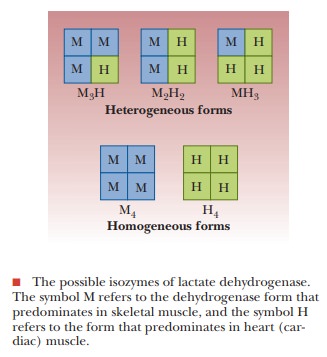Chapter: Biochemistry: The Behavior of Proteins: Enzymes
Enzymes as Markers for Disease
Enzymes as Markers for Disease
Some
enzymes are found only in speciĂžc tissues or in a limited number of such
tissues. The enzyme lactate dehydrogenase (LDH) has two different types of
subunitsÑone found primarily in heart muscle (H), and another found in skeletal
muscle (M). The two different subunits differ slightly in amino acid
composition; consequently, they can be separated electrophoretically or
chromatographically on the basis of charge. Because LDH is a tetramer of four
subunits, and because the H and M subunits can combine in all possible
combinations, LDH can exist in Ăžve different forms, called isozymes, depending on the source. An increase of any form of LDH
in the blood indicates some kind of tissue damage. A heart attack used to be
diagnosed by an increase of LDH from heart muscle. Similarly, there are
different forms of creatine kinase (CK), an enzyme that occurs in the brain,
heart, and skeletal muscle. Appearance of the brain type can indicate a stroke
or a brain tumor, whereas the heart type indicates a heart attack. After a
heart attack, CK shows up more rapidly in the blood than LDH. Monitoring the
presence of both enzymes extends the possibility of diagnosis, which is useful,
because a very mild heart attack might be difĂžcult to diagnose. An elevated
level of the isozyme from heart muscle in blood is a deĂžnite indication of
damage to the heart tissue.
A particularly
useful enzyme to assay is acetylcholinesterase (ACE), which is important in
controlling certain nerve impulses. Many pesticides interfere with this enzyme,
so farm workers are often tested to be sure that they have not received
inappropriate exposure to these important agricultural toxins. In fact, more
than 20 enzymes are typically used in the clinical lab to diagnose disease.
There are highly specific markers for enzymes active in the pancreas, red blood
cells, liver, heart, brain, and prostate gland, and many of the endocrine
glands. Because these enzymes are relatively easy to assay, even using
automated techniques, they are part of the ÒstandardÓ blood test your doctor is
likely to request.

Related Topics